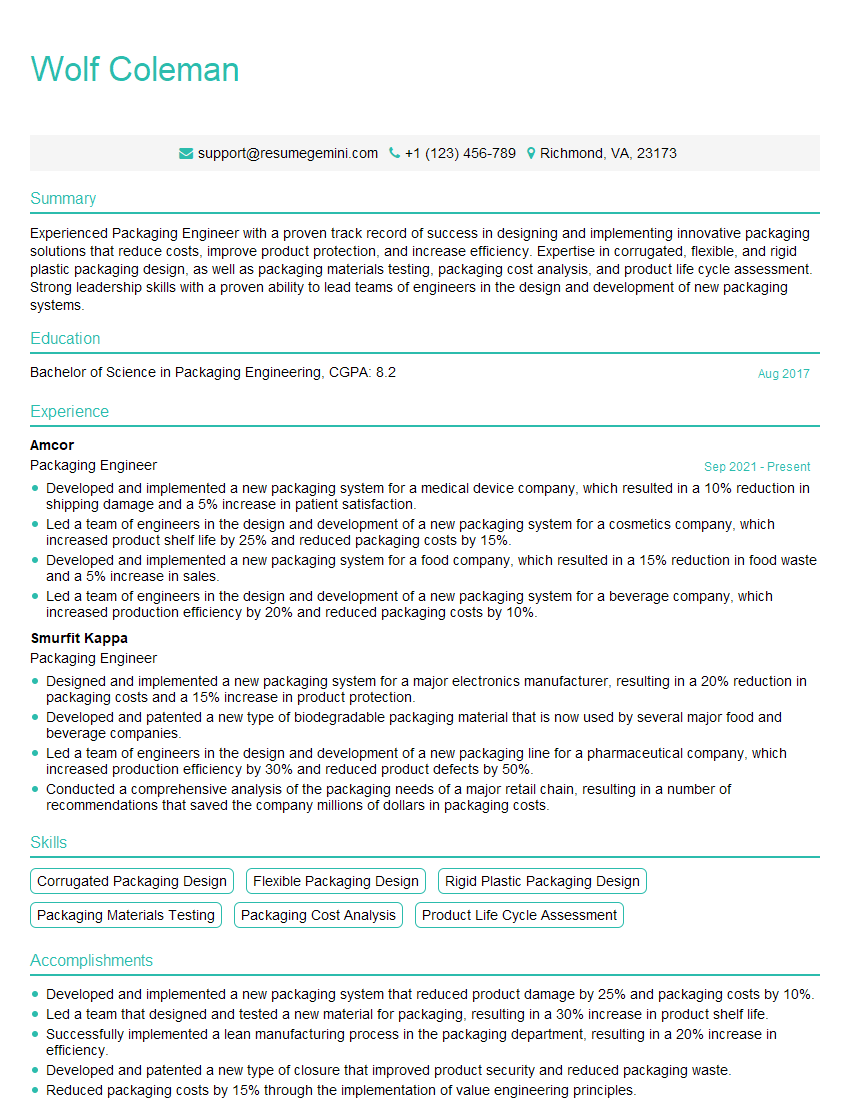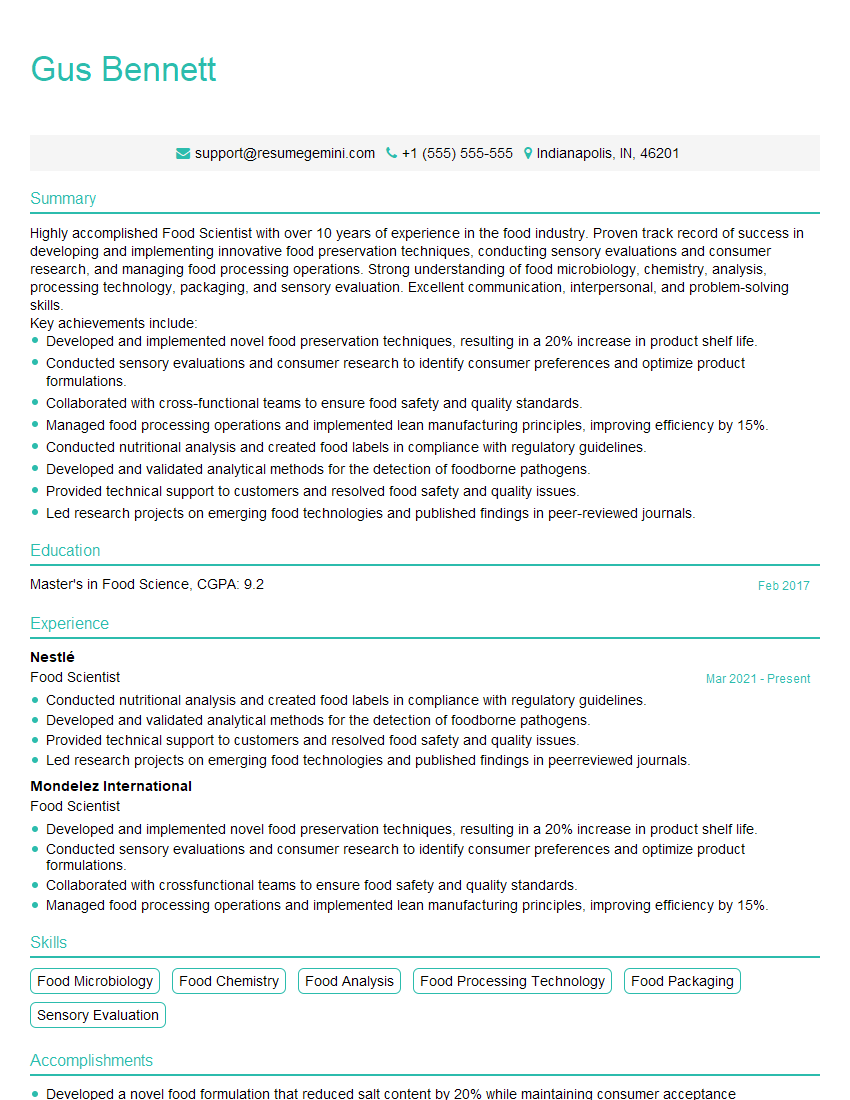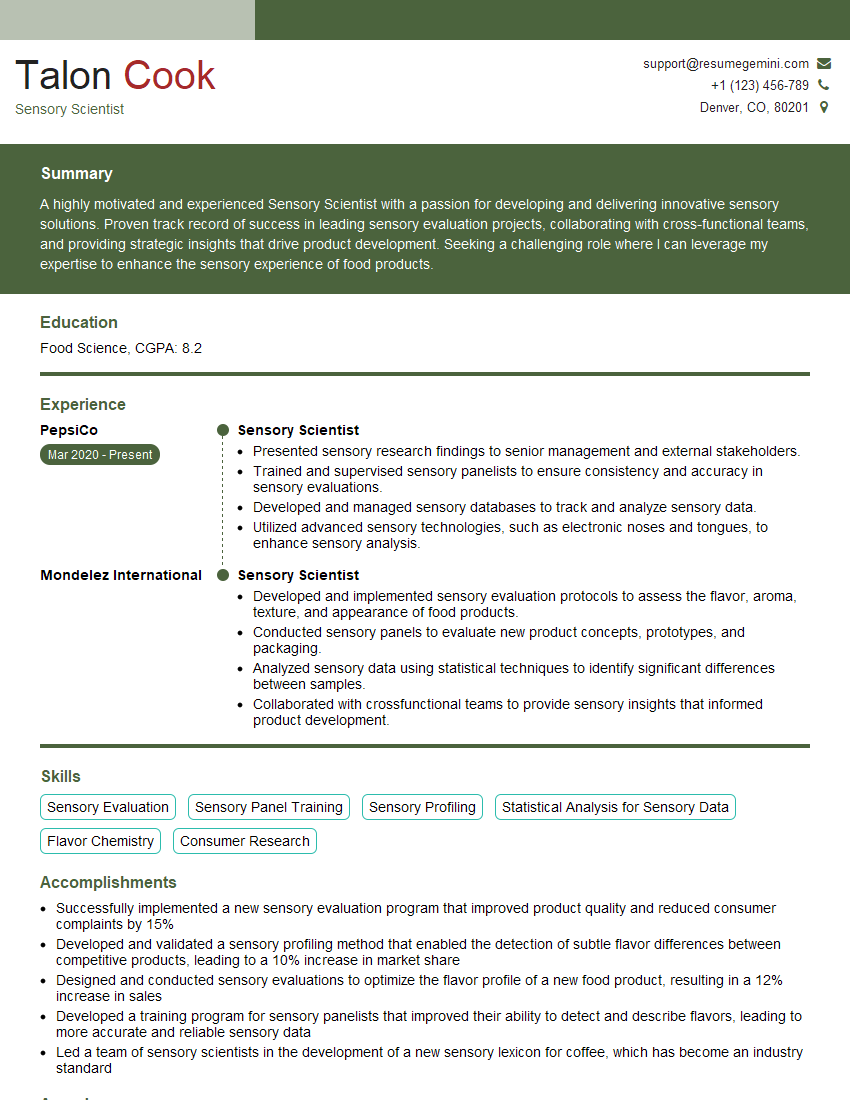Are you ready to stand out in your next interview? Understanding and preparing for Gelatinization interview questions is a game-changer. In this blog, we’ve compiled key questions and expert advice to help you showcase your skills with confidence and precision. Let’s get started on your journey to acing the interview.
Questions Asked in Gelatinization Interview
Q 1. Explain the process of starch gelatinization.
Starch gelatinization is an irreversible process where granular starch absorbs water and swells significantly upon heating. This swelling ruptures the crystalline structure of the starch granule, causing it to lose its birefringence (the ability to refract light differently in two directions), and resulting in a viscous paste. Imagine it like a balloon slowly filling with water until it bursts—the balloon represents the starch granule, and the water represents the absorbed moisture.
The process involves several stages: water uptake, granule swelling, crystalline structure disruption, and finally, the formation of a viscous paste. The exact temperature and time required vary depending on factors such as the type of starch, its concentration, and the presence of other ingredients.
Q 2. Describe the role of water in gelatinization.
Water plays a crucial role in gelatinization. It acts as a plasticizer, breaking hydrogen bonds within the starch granule. This weakening allows the granule to absorb more water and swell. Without sufficient water, the starch granules cannot fully gelatinize, resulting in a grainy or gummy texture. Think of trying to knead bread dough without enough water—it would be hard and impossible to work with.
The water molecules penetrate the starch granule, disrupting the crystalline regions composed of amylopectin and amylose. This process leads to the leaching of amylose molecules into the surrounding water, increasing the viscosity of the mixture.
Q 3. What is the significance of gelatinization temperature?
The gelatinization temperature is the temperature range at which the starch granules begin to swell and lose their birefringence. It’s crucial because it determines when the starch paste becomes viscous and its functional properties are optimal. This temperature isn’t a fixed point but rather a range, typically between 55-70°C (131-158°F) for most starches, but can vary significantly based on the botanical source (e.g., corn, potato, tapioca) and the starch’s processing.
For example, a recipe calling for a thickened sauce would need to reach the gelatinization temperature for the starch to effectively thicken the liquid. Failing to reach this temperature would result in a thin, watery sauce.
Q 4. How does amylose and amylopectin affect gelatinization?
Amylose and amylopectin are the two major components of starch, and they affect gelatinization differently. Amylose, a linear molecule, is responsible for the gel formation and contributes to the paste’s viscosity and texture. During gelatinization, it leaches out of the granule, forming hydrogen bonds with water molecules. Amylopectin, a branched molecule, contributes to the initial swelling of the granule. Its highly branched structure prevents the formation of a strong gel.
High-amylose starches will produce firmer gels, while high-amylopectin starches will result in softer, more viscous pastes. The ratio of amylose to amylopectin determines the final properties of the gelatinized starch.
Q 5. Explain the relationship between gelatinization and viscosity.
Gelatinization and viscosity are directly related. As gelatinization proceeds, the starch granules swell, and amylose leaches out, resulting in an increase in viscosity. The viscosity reaches a peak and then may slightly decrease as the paste cools and retrogradation occurs. The degree of viscosity depends on factors such as starch concentration, temperature, and the type of starch.
Imagine stirring a thickener into a sauce; as you heat and stir, the starch granules gelatinize, and the sauce thickens due to the increased viscosity. This is why starch is a common thickening agent in many food applications.
Q 6. What factors influence the rate of gelatinization?
Several factors influence the rate of gelatinization:
- Type of starch: Different starches gelatinize at different rates and temperatures. For example, waxy corn starch gelatinizes faster than potato starch.
- Starch concentration: Higher concentrations of starch generally lead to faster gelatinization.
- pH: Extreme pH values can slow down or prevent gelatinization.
- Presence of sugars and salts: Sugars and salts can delay the gelatinization process.
- Shear rate: High shear rates during heating can break down the starch granules and reduce viscosity.
- Heating rate: A faster heating rate can lead to faster gelatinization, although excessive heating can cause starch degradation.
Q 7. How does gelatinization affect the texture of food products?
Gelatinization significantly impacts the texture of food products. It’s crucial for creating desired textures in a wide range of foods. For example, the smooth, creamy texture of pudding is directly linked to the gelatinization of the starch. Similarly, the chewy texture of bread crust is partially due to starch gelatinization during baking.
In contrast, incomplete gelatinization can lead to undesirable grainy or gummy textures, as seen in undercooked rice or poorly prepared sauces. Controlling the gelatinization process is essential for achieving the desired texture in any recipe that utilizes starch as a thickening or texturizing agent.
Q 8. Describe the difference between gelatinization and retrogradation.
Gelatinization and retrogradation are both crucial processes involving starch, but they differ significantly. Gelatinization is the irreversible swelling and disruption of starch granules when heated in water. This causes the granules to absorb water, lose their birefringence (the ability to refract light differently in different directions), and thicken the surrounding liquid, forming a viscous paste. Think of it like popcorn popping – the kernel (starch granule) absorbs water and expands dramatically, changing its structure permanently. Retrogradation, on the other hand, is a reversible process occurring after gelatinization where the starch molecules realign themselves, forming crystalline structures that expel water. This leads to syneresis (weeping), where water separates from the gel and makes it more firm or crumbly. Imagine the staling of bread – the initially soft bread becomes harder over time due to retrogradation.
Q 9. How can you control gelatinization in food processing?
Controlling gelatinization in food processing is crucial for achieving desired texture and stability. Several factors can be manipulated:
- Temperature: Precise temperature control during heating is vital. Higher temperatures accelerate gelatinization but can lead to undesirable changes in viscosity or even starch degradation. Lower temperatures slow down the process, allowing for better control.
- Water Content: The amount of water influences the extent of swelling and the final viscosity. Too little water may result in incomplete gelatinization, while too much can lead to a thin and runny product.
- Time: Sufficient heating time is necessary to complete gelatinization. However, prolonged heating can cause starch breakdown and reduce viscosity.
- pH: Acidic conditions hinder gelatinization, while alkaline conditions can enhance it, but too extreme pH can negatively affect the final product.
- Shear Rate: High shear rates during heating can disrupt starch granules, affecting the final viscosity and texture.
- Additives: Sugars and fats can interfere with gelatinization, reducing swelling and viscosity. Some additives, like emulsifiers, can help stabilize the gelatinized starch and prevent retrogradation.
For example, in making a smooth pudding, careful temperature control and sufficient cooking time ensure proper gelatinization, while excessive heating could lead to a lumpy texture.
Q 10. What are the benefits of gelatinization in food applications?
Gelatinization offers numerous benefits in food applications:
- Thickening: It is the primary mechanism for thickening sauces, soups, and puddings. The swollen starch granules create viscosity, giving body to the food.
- Texture Modification: It contributes to a variety of textures, ranging from creamy (custards) to chewy (bread) to firm (jellies), depending on factors like starch type, processing conditions, and added ingredients.
- Stabilization: Gelatinized starch acts as an emulsifier and stabilizer in food products, preventing separation of ingredients.
- Improved Mouthfeel: The creamy or smooth texture of gelatinized starch enhances the overall mouthfeel and palatability of many foods.
- Water Retention: Gelatinized starch binds to water, leading to increased moisture retention in baked goods, preventing them from becoming dry.
Consider the smooth texture of a well-made gravy, achieved through precisely controlled gelatinization of flour. Or the soft texture of bread, where gelatinization creates a matrix holding the other ingredients together.
Q 11. Explain the impact of pH on gelatinization.
pH significantly impacts gelatinization. Acidic conditions (low pH) tend to hinder gelatinization by disrupting the hydrogen bonds within starch molecules, which are essential for water absorption and swelling. This leads to incomplete gelatinization and reduced viscosity. Alkaline conditions (high pH), conversely, can accelerate gelatinization, resulting in faster swelling and higher viscosity. However, extreme pH values (both acidic and alkaline) can damage the starch molecules, leading to degradation and undesirable changes in viscosity and texture.
For instance, making jams with high acidity requires special considerations, as the high acidity can inhibit gelatinization of the added starch. Adding a buffer may be necessary to maintain a more neutral pH.
Q 12. How does shear rate affect gelatinization?
Shear rate, the rate of deformation applied to a fluid, influences gelatinization. High shear rates during heating can cause starch granules to break down mechanically, reducing the viscosity of the final product. This is because the high shear forces disrupt the granule structure before it can fully swell. Low shear rates allow for more complete gelatinization, resulting in higher viscosity and a smoother texture.
Think of making mashed potatoes: vigorous mixing (high shear) might result in a slightly thinner and less smooth texture compared to gentle mixing (low shear).
Q 13. Discuss the role of gelatinization in creating different food textures.
Gelatinization is a key determinant of food textures. The final texture depends on factors like the type of starch, the degree of gelatinization, and other ingredients present.
- Starchy Pastes: Complete gelatinization leads to thick, viscous pastes like in sauces or gravies.
- Elastic Gels: Certain starches form strong, elastic gels when cooled after gelatinization, as seen in jellies or some puddings.
- Crumbly Textures: Incomplete gelatinization or retrogradation can lead to crumbly textures like in some cookies or breads.
- Chewy Textures: The interplay of gelatinization and other ingredients can create chewy textures, as in many baked goods.
The texture of bread, for example, is significantly influenced by the gelatinization of wheat starch. The extent of gelatinization and the resulting network structure determines the final texture.
Q 14. What are some common methods for measuring gelatinization?
Several methods measure gelatinization:
- Brabender Viscoamylography: This technique measures the viscosity changes of a starch suspension during heating and cooling, providing detailed information on gelatinization and retrogradation properties.
- Rapid Visco Analyzer (RVA): This method uses a small-scale rheometer to measure viscosity changes in a starch slurry, providing a rapid assessment of gelatinization characteristics.
- Differential Scanning Calorimetry (DSC): DSC measures the heat flow associated with gelatinization, providing information on the enthalpy and temperature range of gelatinization.
- Polarized Light Microscopy: This technique allows visualization of starch granule morphology before and after gelatinization, observing changes in birefringence as an indicator of gelatinization.
- X-ray Diffraction: X-ray diffraction can be used to determine the degree of crystallinity in starch before and after gelatinization.
The choice of method depends on the specific information required and available resources. For a quick assessment of gelatinization, RVA is often preferred. For detailed rheological information, Brabender Viscoamylography might be better.
Q 15. How can you prevent retrogradation after gelatinization?
Retrogradation is the process where gelatinized starch molecules, after cooling, begin to realign and recrystallize, resulting in a firmer, less desirable texture. Think of it like the slow separation of oil and water in a vinaigrette – the components that initially mixed are now separating again. To prevent this, we need to disrupt this recrystallization process.
- Rapid Cooling: Quickly cooling the starch paste prevents the molecules from having enough time to rearrange themselves.
- Adding Sugar or Fat: Sugar and fat molecules interfere with starch molecule interactions, hindering their ability to recrystallize. Imagine them acting as tiny obstacles, preventing the starch molecules from neatly aligning.
- Modifying Starch Structure: Using modified starches (discussed in the next question) can alter the starch molecule structure to make it less prone to retrogradation.
- Freezing and Thawing: While freezing might initially seem counterintuitive, controlled freezing and thawing cycles can limit the extent of retrogradation by disrupting the crystalline structure.
- Controlling Moisture Content: Reducing the available water reduces the mobility of starch molecules, slowing down retrogradation. Think of it like drying out concrete; it’s much harder to rework.
For example, in making bread, rapid cooling and the addition of fat in the form of butter contribute to a softer crumb, preventing excessive retrogradation and resulting in a more enjoyable texture.
Career Expert Tips:
- Ace those interviews! Prepare effectively by reviewing the Top 50 Most Common Interview Questions on ResumeGemini.
- Navigate your job search with confidence! Explore a wide range of Career Tips on ResumeGemini. Learn about common challenges and recommendations to overcome them.
- Craft the perfect resume! Master the Art of Resume Writing with ResumeGemini’s guide. Showcase your unique qualifications and achievements effectively.
- Don’t miss out on holiday savings! Build your dream resume with ResumeGemini’s ATS optimized templates.
Q 16. Describe the use of modified starches in gelatinization.
Modified starches are created by chemically or physically altering native starches to change their properties, such as gelatinization temperature, viscosity, texture, and resistance to retrogradation. These modifications are tailored to specific applications.
- Cross-linked Starches: These starches have chemical cross-links between starch molecules, increasing their stability and reducing viscosity loss during cooking and preventing retrogradation. They are used in frozen foods to maintain texture and prevent syneresis (water separation).
- Acid-thinned Starches: These starches have been treated with acid, leading to lower viscosity and improved freeze-thaw stability. They’re commonly found in sauces and fillings.
- Hydroxypropyl Starch: This starch has increased water-holding capacity and reduced retrogradation, making it ideal for applications where smoothness and shelf life are crucial, such as in confectionery and processed meats.
- Pre-gelatinized Starches: These starches have been gelatinized and then dried, making them instantly soluble in cold water, useful for convenience foods and instant desserts.
For instance, the smooth texture of many instant pudding mixes is a direct result of using pre-gelatinized starch, while the freeze-thaw stability of frozen pizzas relies on modified starches with reduced retrogradation.
Q 17. What are the challenges associated with controlling gelatinization?
Controlling gelatinization is crucial for achieving desired food texture and functionality, but several challenges exist:
- Precise Temperature Control: Gelatinization occurs within a specific temperature range, and deviations can lead to inconsistent results. Overheating can result in viscosity loss, while underheating can lead to incomplete gelatinization.
- Shear Stress: High shear forces, such as those generated by high-speed mixing, can damage the starch granules and reduce viscosity. Think of vigorously whisking – you can disrupt the structure of the starch.
- Starch Concentration: The concentration of starch affects the viscosity and texture of the final product. An overly concentrated mixture can be too viscous, while a dilute mixture will lack the desired thickening power.
- pH and Other Additives: pH can affect gelatinization temperature and starch solubility. Other ingredients like salts and sugars can also impact the process.
- Starch Type: Different starches have unique gelatinization properties, demanding careful parameter adjustments based on the specific starch being used.
For example, in the production of sauces, achieving a smooth and consistent texture requires precise temperature control and careful management of shear stress during the gelatinization process. Improper control can lead to lumps or a grainy consistency.
Q 18. How does gelatinization affect the digestibility of starch?
Gelatinization significantly impacts starch digestibility. Raw starch granules are relatively resistant to digestion because of their tightly packed crystalline structure. Enzymes in our digestive system have difficulty accessing the starch molecules within these granules.
Gelatinization disrupts this structure, making the starch molecules more accessible to enzymatic attack. This leads to a much greater rate of digestion and absorption of glucose.
Therefore, gelatinized starch is more readily digestible than raw starch. This is why cooked starches are easier to digest than raw ones, a crucial aspect for infant nutrition and for individuals with compromised digestive systems.
Q 19. Explain the concept of pasting in relation to gelatinization.
Pasting is the process that occurs after gelatinization, where the starch granules have completely swollen and burst, leading to a viscous paste. It’s a crucial stage in determining the final texture and rheological properties (flow and deformation behavior) of the starch-based product.
Imagine blowing up a balloon (starch granule). Gelatinization is like the balloon swelling. Pasting is when the balloon bursts, releasing its contents and forming a more viscous mass.
Factors influencing pasting include temperature, shear rate, and the type of starch used. The viscosity of the paste determines the final consistency of foods like sauces, jams, and soups. A well-controlled pasting process is vital for achieving the desired thickness and texture.
Q 20. What is the impact of different types of starch on gelatinization?
Different types of starch have unique gelatinization properties. These differences stem from variations in their amylose and amylopectin content, granule size and shape, and the degree of branching in the amylopectin molecules.
- Amylose Content: High-amylose starches (like waxy maize starch) have higher viscosity and stronger gel formation than low-amylose starches (like potato starch). High amylose leads to a stronger gel, which sets up firmer.
- Granule Size: Smaller granules tend to gelatinize at lower temperatures and produce a higher viscosity than larger granules. This influences the cooking time and temperature required.
- Starch Source: Starches from different sources (e.g., corn, potato, tapioca, rice) have distinct gelatinization profiles. For example, potato starch gelatinizes at a lower temperature than corn starch.
Understanding these differences is crucial for choosing the right starch for a specific application. For example, waxy maize starch is commonly used in frozen foods to maintain texture due to its high viscosity, while potato starch is preferred for some sauces and soups because of its lower gelatinization temperature.
Q 21. How can you determine the degree of gelatinization?
The degree of gelatinization can be determined using several methods:
- Visual Inspection: Examining the transparency and consistency of the starch paste offers a preliminary assessment. A completely gelatinized starch will be translucent and viscous.
- Microscopy: Examining the starch granules under a microscope can reveal the extent of swelling and granule disruption, offering direct visual confirmation.
- Rheological Measurements: Using instruments like a viscometer or rheometer allows for precise measurements of viscosity and other rheological properties as a function of temperature, which correlates strongly with the degree of gelatinization.
- Brabender Viscoamylograph: This specialized instrument measures viscosity changes during heating and cooling, providing a detailed profile of starch gelatinization and pasting properties.
- Differential Scanning Calorimetry (DSC): DSC measures the heat absorbed during gelatinization, allowing for precise determination of the gelatinization temperature range and enthalpy (heat of gelatinization), which indicates the completeness of the process.
The choice of method depends on the level of detail required and the resources available. For example, a simple visual inspection is sufficient for many basic applications, while DSC provides highly accurate and detailed information for research purposes.
Q 22. Discuss the role of gelatinization in creating stable food emulsions.
Gelatinization, the irreversible swelling and gelatinization of starch granules when heated in water, plays a crucial role in creating stable food emulsions. Think of mayonnaise – its creamy texture and stability depend heavily on the gelatinization of the starch (often from the egg yolk). The process works in two key ways:
Increased Viscosity: Gelatinization increases the viscosity of the aqueous phase. This thicker, more viscous medium helps to stabilize the emulsion by reducing the coalescence (merging) of oil droplets. Imagine trying to mix oil and water – it separates quickly. But a thickened, starchy liquid acts like a physical barrier, preventing the oil droplets from coming together and separating.
Emulsifying Properties: Starch, after gelatinization, can act as an emulsifier itself or enhance the activity of other emulsifiers. The gelatinized starch granules form a three-dimensional network which encapsulates and traps the dispersed oil droplets, thereby enhancing emulsion stability. This is similar to how soap molecules stabilize an emulsion by reducing surface tension. The starch network, instead of soap molecules, provides this stabilization.
Therefore, proper control of gelatinization temperature and time is crucial in creating stable emulsions in foods like sauces, dressings, and bakery fillings.
Q 23. How does gelatinization affect the freeze-thaw stability of food products?
Freeze-thaw stability is significantly impacted by gelatinization. During freezing, ice crystals form, which can disrupt the food structure and lead to undesirable changes in texture. Gelatinization plays a role in mitigating these effects:
Improved Structure: Properly gelatinized starch forms a strong three-dimensional network. This network can provide structural support, reducing the damage caused by ice crystal formation during freezing and the subsequent thawing. This is because the network can withstand the stresses created by the expanding ice crystals.
Water Binding: Gelatinized starch binds water effectively. This reduces the amount of free water available for ice crystal formation. Less free water means less ice crystal growth, resulting in better preservation of texture after thawing. Think of it like a sponge – a dry sponge absorbs water readily, while a gelatinized starch acts like a pre-soaked sponge, less prone to further water absorption that would lead to ice crystal formation.
However, incomplete or excessive gelatinization can be detrimental. Incomplete gelatinization can lead to a weak network, while excessive gelatinization can result in syneresis (separation of liquid) during freezing and thawing, significantly impacting the final product’s quality.
Q 24. Explain the use of Differential Scanning Calorimetry (DSC) in studying gelatinization.
Differential Scanning Calorimetry (DSC) is a powerful technique used to study the gelatinization process. It measures the heat flow associated with phase transitions in a material as a function of temperature. In the context of starch gelatinization, DSC allows us to:
Determine the Gelatinization Temperature Range: DSC reveals the onset, peak, and conclusion temperatures of gelatinization. This information is critical for optimizing processing conditions to achieve desired properties.
Measure the Enthalpy of Gelatinization: This quantifies the amount of energy absorbed during gelatinization, reflecting the strength of the starch-water interactions. A higher enthalpy generally indicates stronger interactions and potentially better stability.
Analyze the Effect of Different Factors: DSC can be used to study the influence of factors like starch type, moisture content, additives, and processing conditions (e.g., heating rate) on gelatinization behavior.
The DSC thermogram displays an endothermic peak corresponding to the gelatinization process. The peak’s area is directly proportional to the enthalpy of gelatinization, offering valuable insights into the starch’s properties and potential application suitability.
Q 25. Describe the role of gelatinization in the production of bread.
Gelatinization is fundamental to bread making. The starch in the flour undergoes gelatinization during baking, playing a critical role in the bread’s structure and texture. Specifically:
Structure Formation: The gelatinized starch forms a viscoelastic matrix that provides the bread with its structure and holds the gas produced by the yeast (or chemical leavening agents). This network traps gas bubbles, leading to a light and airy crumb.
Water Binding: Gelatinized starch binds water, contributing to the moisture content and softness of the bread. This also influences the crumb texture, making it less dry and more palatable.
Gelatinization Temperature Control: The temperature and duration of gelatinization influence the bread’s characteristics. For example, ensuring a complete gelatinization process is essential for creating a properly structured crumb and avoiding a gummy texture.
In short, controlling the gelatinization of starch in bread making is crucial for achieving the desired texture, volume, and overall quality of the final product.
Q 26. How does gelatinization impact the sensory attributes of food?
Gelatinization significantly impacts the sensory attributes of food, influencing:
Texture: Gelatinization is responsible for the textural changes from a raw, granular feel to a smooth, cohesive, or even gummy texture, depending on the degree of gelatinization. Think of the difference between raw rice and cooked rice.
Mouthfeel: The viscosity of gelatinized starch significantly impacts mouthfeel. High viscosity translates to a thicker, creamier mouthfeel, while lower viscosity leads to a thinner consistency.
Appearance: Gelatinization can alter the appearance of foods, particularly the translucency and glossiness. For instance, the appearance of a translucent cooked starch paste versus raw starch powder is significantly different.
Furthermore, the extent of gelatinization influences the overall sensory experience. Incomplete gelatinization might lead to a gritty texture, while excessive gelatinization can result in a rubbery or pasty mouthfeel.
Q 27. What are some common industrial applications of controlled gelatinization?
Controlled gelatinization finds numerous industrial applications, including:
Starch Modification: Controlled gelatinization is used to modify starch properties for applications like creating starch-based thickeners, films, and coatings.
Food Processing: Many food products such as sauces, soups, and confectionery rely on controlled gelatinization to achieve the desired texture, viscosity, and stability.
Paper and Textile Industries: Gelatinized starch finds applications as sizing agents and adhesives in the paper and textile industries.
Biotechnology: Controlled gelatinization plays a role in certain biotechnological processes involving starch-based materials.
Precise control over the gelatinization process is crucial in these industries to guarantee consistent product quality and performance. This control involves careful manipulation of factors such as temperature, time, and the presence of additives.
Q 28. Explain how gelatinization contributes to the overall quality of a food product.
Gelatinization contributes significantly to the overall quality of a food product by influencing a wide range of attributes:
Texture and Mouthfeel: As previously discussed, gelatinization determines the texture and mouthfeel, contributing significantly to the sensory experience and consumer acceptance.
Stability: Proper gelatinization enhances the stability of emulsions and suspensions, preventing separation and maintaining a uniform consistency throughout the product’s shelf life.
Appearance: The visual appeal of food products is often influenced by gelatinization. The translucency, gloss, and overall visual appearance are strongly influenced by the degree of gelatinization.
Nutritional Value: While gelatinization doesn’t directly alter the nutritional content, it affects the digestibility of starch, making it more readily available for absorption in the body.
In conclusion, mastering gelatinization control is critical in delivering high-quality food products with consistent texture, stability, and appealing sensory properties.
Key Topics to Learn for Gelatinization Interview
- Understanding the Process: Master the fundamental principles of gelatinization – the irreversible swelling and gelatinization of starch granules upon heating in the presence of water. Understand the role of temperature, water content, and other factors.
- Starch Structure and Properties: Explore the various types of starch (e.g., amylose, amylopectin) and how their structures influence their gelatinization properties. Be prepared to discuss the impact of different starch sources on the final product.
- Practical Applications in Food Science: Discuss the application of gelatinization in various food products such as bread making, sauces, and confectionery. Understand how gelatinization affects texture, viscosity, and other sensory properties.
- Rheological Properties: Familiarize yourself with the rheological changes that occur during gelatinization. Be able to discuss viscosity, elasticity, and other rheological parameters and how they are measured and interpreted.
- Factors Affecting Gelatinization: Understand how factors such as pH, the presence of sugars, lipids, and other additives affect the gelatinization process. Be prepared to troubleshoot potential problems related to these factors.
- Retrogradation and Syneresis: Learn about the processes of retrogradation (re-crystallization of starch) and syneresis (separation of water from a gel) and their impact on food quality and shelf life.
- Advanced Techniques: Explore advanced techniques related to starch modification and its impact on gelatinization properties. This could include pre-gelatinized starches or chemically modified starches.
Next Steps
Mastering gelatinization is crucial for success in various food science and related fields, opening doors to exciting career opportunities. A strong understanding of this process will demonstrate your technical expertise and problem-solving abilities to potential employers. To significantly improve your job prospects, invest time in crafting an ATS-friendly resume that highlights your skills and experience effectively. ResumeGemini is a trusted resource that can help you build a professional and impactful resume tailored to the specific demands of your target roles. Examples of resumes specifically tailored for Gelatinization-focused positions are available to help you create a winning application.
Explore more articles
Users Rating of Our Blogs
Share Your Experience
We value your feedback! Please rate our content and share your thoughts (optional).
What Readers Say About Our Blog
Dear Sir/Madam,
Do you want to become a vendor/supplier/service provider of Delta Air Lines, Inc.? We are looking for a reliable, innovative and fair partner for 2025/2026 series tender projects, tasks and contracts. Kindly indicate your interest by requesting a pre-qualification questionnaire. With this information, we will analyze whether you meet the minimum requirements to collaborate with us.
Best regards,
Carey Richardson
V.P. – Corporate Audit and Enterprise Risk Management
Delta Air Lines Inc
Group Procurement & Contracts Center
1030 Delta Boulevard,
Atlanta, GA 30354-1989
United States
+1(470) 982-2456










